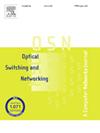Optical networks are vulnerable to failures due to targeted attacks or large-scale disasters. The recoverability of optical networks refers to the ability of an optical network to return to a desired performance level after suffering topological perturbations such as link failures. This paper proposes a general topological approach and recoverability indicators to measure the network recoverability for optical networks for two recovery scenarios: 1) only the links which are damaged in the failure process can be recovered and 2) links can be established between any pair of nodes that have no link between them after the failure process. We use the robustness envelopes of realizations and the histograms of two recoverability indicators to illustrate the impact of the random failure and recovery processes on the network performance. By applying the average two-terminal reliability and the network efficiency as robustness metrics, we employ the proposed approach to assess 20 real-world optical networks. Numerical results validate that the network recoverability is coupled to the network topology, the robustness metric and the recovery strategy. We further show that a greedy recovery strategy could provide a near-optimal recovery performance for the robustness metrics. We investigate the sensitivity of network recoverability and find that the sensitivity of the recoverability indicators varies according to different robustness metrics and scenarios. We also find that assortativity has the strongest correlation with both recoverability indicators.


